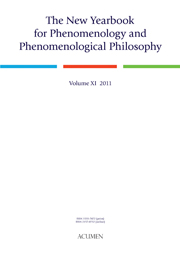Book contents
- Frontmatter
- Contents
- Articles
- Husserl and the Mind–Body Problem
- Phenomenological Kaleidoscope: Remarks on the Husserlian Method of Eidetic Variation
- Husserl and McDowell on the Role of Concepts in Perception
- Edmund Husserl's Europe: Borders, Limits and Crises
- The Ontological Status of Essences in Husserl's Thought
- Heidegger on Understanding One's Own Being
- Discussion
- In Review
- Conclusion
Phenomenological Kaleidoscope: Remarks on the Husserlian Method of Eidetic Variation
from Articles
- Frontmatter
- Contents
- Articles
- Husserl and the Mind–Body Problem
- Phenomenological Kaleidoscope: Remarks on the Husserlian Method of Eidetic Variation
- Husserl and McDowell on the Role of Concepts in Perception
- Edmund Husserl's Europe: Borders, Limits and Crises
- The Ontological Status of Essences in Husserl's Thought
- Heidegger on Understanding One's Own Being
- Discussion
- In Review
- Conclusion
Summary
Abstract: The main goal of this article is to examine Edmund Husserl's method of “eidetic variation”—that is, to examine the way this method is supposed to work in connection with the notion of “similarity” (Ähnlichkeit). Unlike most interpretations, it will be suggested that similarity represents the leading methodological principle of eidetic variation. We will argue, therefore, that, on the one hand, this method is rooted in the sphere of association and passivity while, on the other hand, it is constituted by the transposition of a passive synthesis into an active operation. After having introduced and discussed a twofold notion of phantasy (as “localized phantasy” and as “pure phantasy”) as well as a twofold concept of eidos (as “hen epi pollon” and as “pure eidos”), the extent to which for Husserl there cannot be any eidetic variation without a monadology will be shown.
Keywords: Edmund Husserl; eidetic variation; monadology; phenomenological method.
The “kaleidoscope” is the image introduced by Edmund Husserl in his Freiburg lectures Einleitung in die Philosophie (1922/23) to account for the possibility of phantasy-variation. In the relevant passages Husserl describes a “centaur” that can be phantasized as being “blond,” having a “long beard,” or still otherwise. Each new formation passes over into another one, “yet not in the way of a changing, but rather as a dissonant modification”: “It looks like a kaleidoscope: always new formations having nothing to do with each other”.
- Type
- Chapter
- Information
- The New Yearbook for Phenomenology and Phenomenological PhilosophyVolume XI 2011, pp. 16 - 41Publisher: Acumen PublishingPrint publication year: 2012



